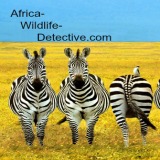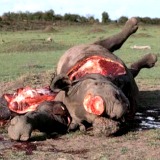The Majestic Common Eland:
A Look at the World's Largest Antelope Species
The Common Eland, the world's largest antelope, is a stunningly magnificent creature.
It captures the imagination of both nature enthusiasts and wildlife photographers due to its amazing size, distinguishing features, and graceful movements.
This gentle giant demands attention wherever it goes, standing tall at an average shoulder height of 1.6 meters and weighing up to 900 kg.
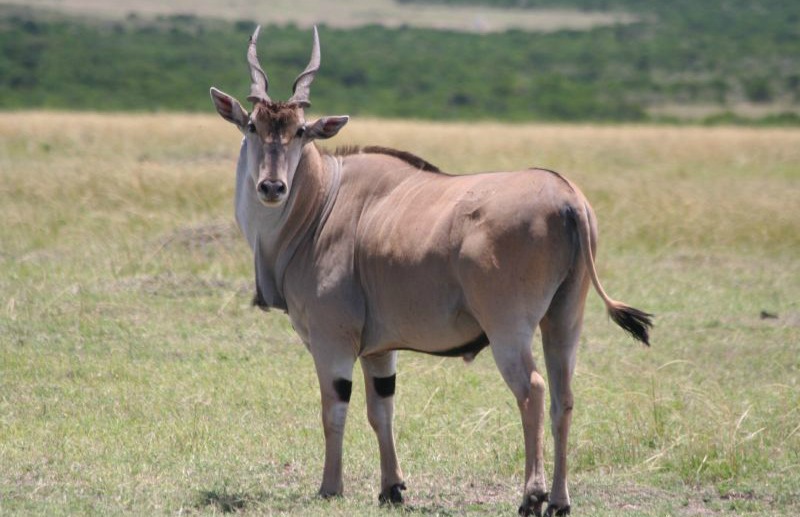 Eland bull has a brown patch on the back of the forelegs
Eland bull has a brown patch on the back of the forelegsThe Eland is sometimes called an antelope in an ox's clothing.
The "oxlike" characteristics develop in the adult males, including the thick neck dewlap which reminds one of a Brahma bull.
Why do Elands have a dewlap?
Elands have a dewlap (a loose flap of skin hanging from their neck) for a variety of reasons:
1. Thermoregulation (cooling system)
The dewlap increases surface area, allowing elands to disperse heat in hot settings. Blood veins in the dewlap may help to cool the body as air passes over it, similar to how elephants' huge ears function.
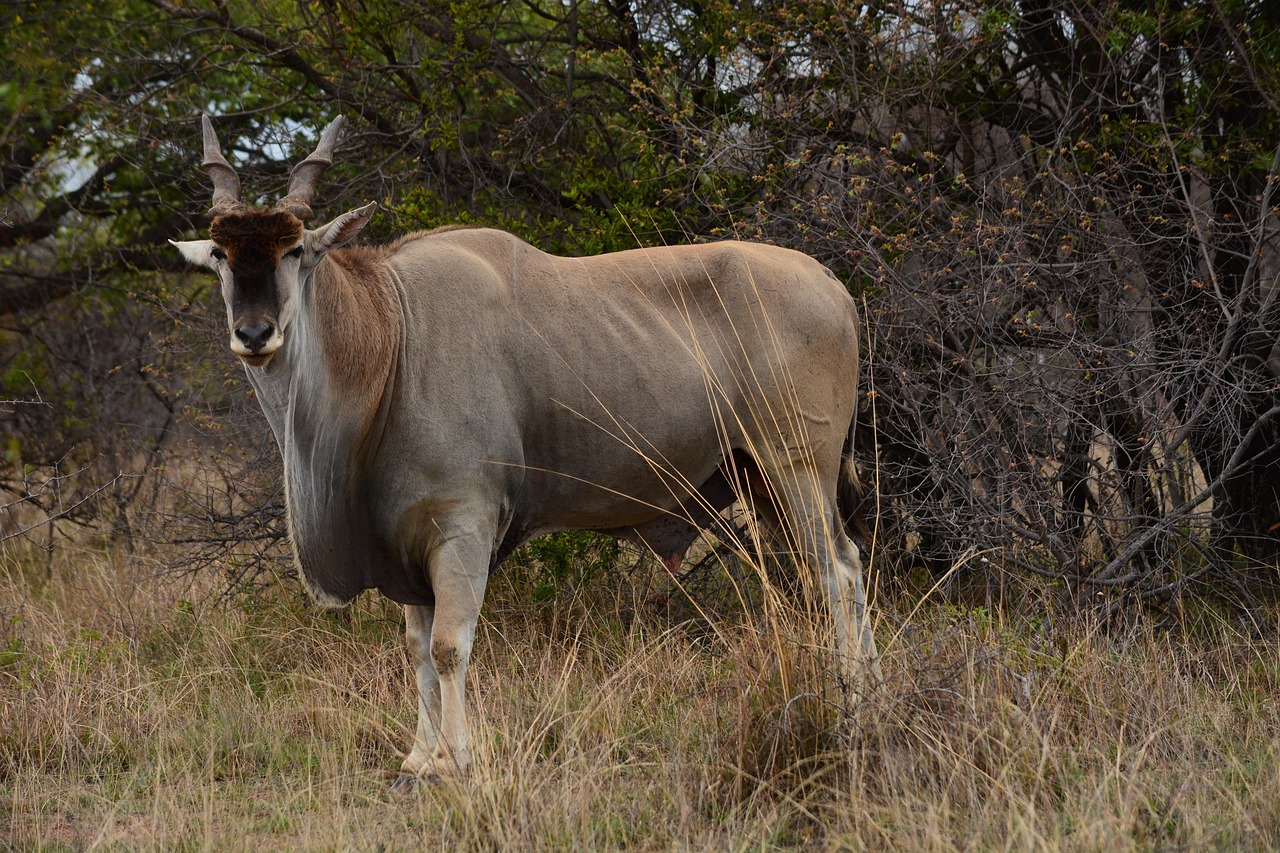
2. Sexual Selection and Dominance.
Larger dewlaps in men may indicate strength, maturity, and genetic fitness, making them more appealing to females. It could also help intimidate competitor males during dominance displays.
3. Fat Storage and Energy Reserve.
Some experts believe the dewlap can retain fat reserves, allowing elands to survive in times of food scarcity.
4. Species Identification
The dewlap, paired with size and horn shape, may assist elands in recognizing their own species and distinguishing individuals within a herd.
While the actual reason remains unknown, the cooling and dominance display theories are the most frequently accepted interpretations.
Eland interesting quick facts
The Eland is a bovine with short, spirally twisted horns in both sexes
It stands seventy inches at the shoulder and weighs up to 2,000 pounds.
World record - the largest
The Eland is the world's largest antelope.
Color is called dull fawn.
They have up to five vertical white stripes on the flanks.
As the bulls mature, they become increasingly grey, especially on the neck.
Males have a patch of stiff, deep brown hair on the forehead.
A dominant bull will bellow to advertise his superior status.
A cow clicks and grunts to attract her calf, which answers by bleating.
|
Anatomy |
Male |
Female |
|
Shoulder height |
1,7 meters |
1,5 meters |
|
Weight |
700 kilograms |
460 kilograms |
Habitat adaptations
Eland can adapt to a wide range of conditions. They occur in arid scrub regions, savannas, woodland, and grassland areas
They can function independent from water.
They sometimes migrate long distances to find food.
What do eland eat? Diet & grazing habits
Elands are both browsers and grazers.
They are browsers but will feed on green grass during the rains and then switch to the foliage (leaves, flowers, and branches) during the dry season.
They are not very selective feeders.
They will browse on leaves, twigs, fruit, and berries.
The rainy season diet consists of 50 – 80% green grass.
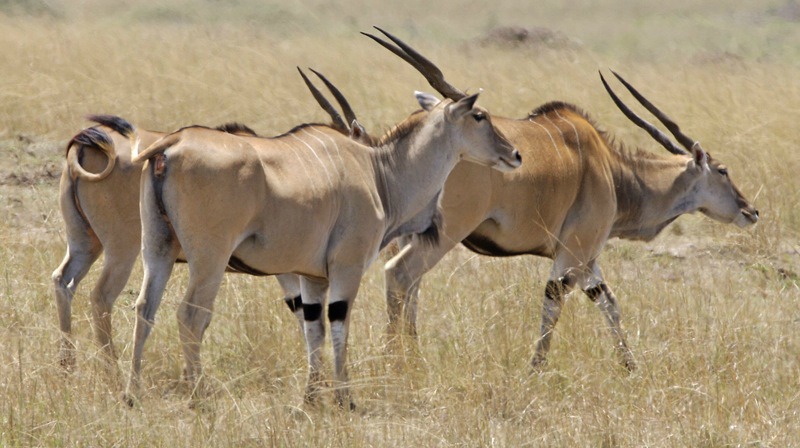
They feed long hours to sustain their considerable bulk.
These bovids sometimes feed at night when vegetation contains more water.
If the foliage of a tree is out of reach you will notice how it can break a branch between its horns.
|
Gestation period |
9 months |
|
Birth weight |
32 - 36 kilograms |
|
Weaned |
6 - 8 months |
|
Males' maturity |
18 months |
|
Lifespan |
12 - 20 year |
|
|
Are these African animals highly gregarious or can they be aggresive?
Information about these wildlife animals indicate that their basic social units are small herds of which the composition changes seasonally.
They split into mixed-sex adult herds and herds of juveniles and sub adults.
During the winter cows and bulls herd separately.
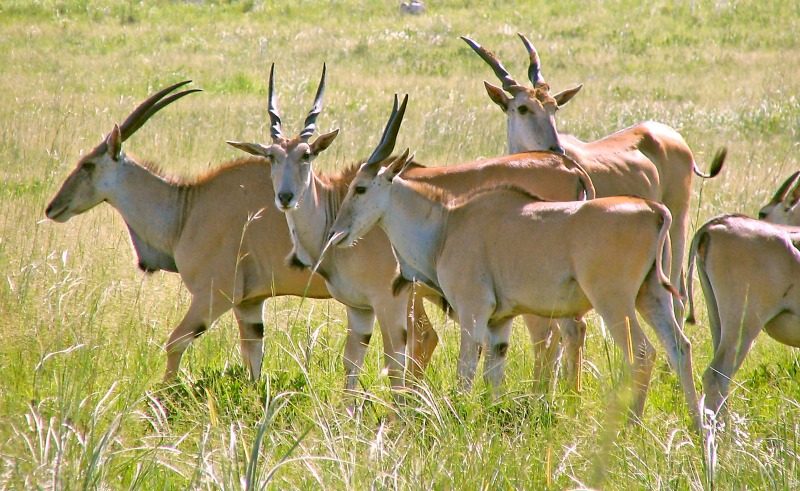 During the winter kudu cows and bulls herd separately
During the winter kudu cows and bulls herd separatelyDuring spring, the calving females join the younger animals to form a nursery herd.
In areas where food is available all year they are settled and don’t roam much.
These African animals are not territorial.
Eland calves are very gregarious.
As they get older the male becomes increasingly solitary.
Eland are known for their relative lack of aggression and docility.
Nevertheless, there are scenarios in which their behavior can alter:
During the mating season, known as the rut, male elands may exhibit aggressiveness and territorial behavior towards one another. They show off their huge, spiraling horns.
Posturing & Threats: They frequently use their body size, dewlap display, and the loud clicking sound of their ankles to demonstrate dominance before engaging in combat.
Eland tends to be timid and avoid conflict wherever possible, but when cornered, they are capable of defending themselves with strong kicks and pointed horns.
They may charge when injured or trying to protect its young.
Interactions Between Humans as Captives: Some accounts indicate that hand-reared bulls might become dangerous because they lose their innate fear of humans and may perceive them as competitors.
Additionally, males in farms or reserves can display territorial violence, particularly during mating seasons.
What do Eland antelope facts indicate about their breeding habits?
All the animals in a herd, females as well as males, regularly test each other's urine by smelling and tasting.
When the male detects a female on heat the dominant bull will stay close to the female and drives away any other suitors.
He courts the female by:
- rubbing his head against
her flanks,
- resting his chin on her back,
- sniffing and licking her
genitals,
- and pawing the ground.
A calf can stand soon after birth and can follow its mother after three to four hours.
The calf of this African ungulate will stay hidden for the first two weeks.
The mother and calf will join the herd four to six weeks after the birth.
A calf will try to suckle from other females besides its mother.
A female will allow only her own to suckle and aggressively repel attempts from other calves.
A herd's females will work together to defend all juveniles when attacked by predators while the calves run to safety.
Calves develop strong bonds with each other by spending a lot of time grooming and licking each other.
How do Eland defend themselves against predators?
These African animals are slow runners and cannot run faster than 25 miles per hour.
They can however maintain a fast trot indefinitely.
Despite their heavy physique they are however remarkably agile and they can easily clear a two-meter fence.
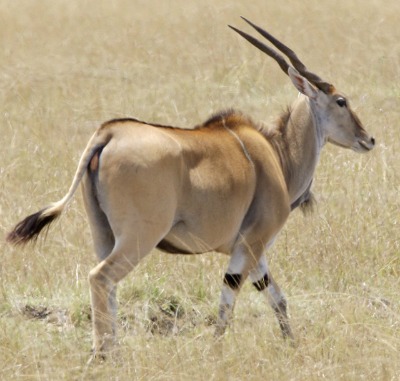 Eland bulls can jump a two-meter fence.
Eland bulls can jump a two-meter fence.Because of its enormous size it always has a decent chance against attacking predators.
Big bulls show little fear for predators.
If a group is attacked, they may bunch with their heads together to present a ring of kicking back legs to the predators.
The large males will take the front positions thereby protecting the calves and pregnant females.
What animals eat Eland?
Only leopards and spotted hyenas can prey on adults.
Leopards, spotted hyenas and wild dogs take calves as prey.
Do these African wild animals have a clear dominance hierarchy in the herd?
In an eland herd males and females have different dominance hierarchies.
Larger, older animals are high ranking and bulls dominate cows.
If you see these wildlife animals shaking their heads (with the head held up high) you are witnessing a threat display.
If they are shaking their heads with their heads down while moving away - it is a sign of submission.
Dominant animals will keep their ears up while subordinates will keep them down.
The dominant animal will often move the subordinate animals away from their favorite spots by issuing a few blows with the sides of the horns.
The most serious threat is a head-down charge with the ears held horizontal.
Eland Bulls fight over females in heat by clashing and locking horns with pushing and twisting against each other.
The loser will turn and run horn wounds are sometimes fatal.
Friendly interactions among herd members are usually in the form of grooming one another.
This involves a process in which one animal will lick the head, neck, and rump of the other.
What is the clicking sound in the Eland?
When an eland moves, its ankle joints make a clicking sound. Tendons that slip over bones or snap back into position when the animal moves are what provide this characteristic clicking sound.
Potential Causes of the Click:
Social Signaling and Communication:
The sound may aid eland animals in following one another through dense undergrowth or while moving.
Dominance Display:
The louder clicks of larger, more experienced bulls may be interpreted by other males as a status symbol.
Mechanical Function:
It might be a result of their size, as some giant animals have joints that pop.
This clicking is a distinctive feature of elands among antelope species and is loud enough to be heard from a distance.
